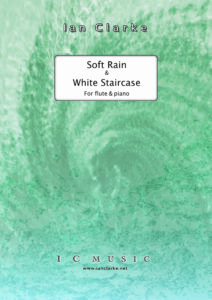Soft Rain and White Staircase

Soft Rain and White Staircase – (flute & piano) [open-hole with closed-hole fingering options – Bft with Cft options)
First Edition published August 2024
A warm welcome to the first published edition of Soft Rain and White Staircase each of which can be viewed as an independent piece. Further information is likely to appear on Ian’s website including possible reference audio clips so a visit might answer a number of questions. Check under the publications sections or do a search if you can’t find what you’re looking for. Just performed by Ian and NFA 2024, San Antonio, Texas.
Click below to hear Soft Rain demo clip:
Click below to hear White Staircase demo clip:
Staff Pick – Just Flutes
“More great music from Ian Clarke” – Chris Hankin
“These pieces are beautiful. Soft Rain is an evocation of that lovely feeling of being out in a shower without a care in the world. Fragments of melody, longer phrases and trademark timbral effects combined with a gentle accompaniment bring the whole texture together. White Staircase uses a rising and falling scale motif in the accompaniment to support an unsettled 5/8 flute line. This is coloured by beatbox hi-hats, Quantz-style tonguing, harmonics and more timbral flips which all add to the strangeness of the soundworld here. Working equally equally well for closed-hole flute, this is another sure fire winner from the imaginative pen of Ian Clarke.“
Soft Rain – performance notes (Cft open-hole with closed-hole alternatives)
The title Soft Rain attempts to hint at some essence of the piece however it is not a programmatic title. The piano part has liquid quality above which the flute gestures and sings. One might think of Summer rain falling on a beautiful stream or river. Alternatively you may wish to experience it entirely as a personal response to the music directly. The music is the most articulate description of itself.
Bends – It’s preferable to perform on an open-holed instrument in order to execute the bends which are integral to the piece. The diamond headed notes are played with the open-holed fingerings indicated. The transition to and from this fingering will give the bend effect. This is most often done via the opening of one open-hole. A fluid movement in the hand is desirable both to enable a smooth technical execution and also mirror the smooth gesture.
Closed-hole flute players may find the piece works well playing the diamond-headed notes with regular fingerings.
Open-hole finger vibrato – this is indicated by a wavy line e.g. bars 54-57. Moving from the regular fingering to the given open-hole fingering gives a strong pitch vibrato. At the time of writing this is an unusual technique for the vast majority of flute players so it is recommended to give time for it to develop in the body. The fluidity in the hand and wrist that a string player uses is some indication of the technique. Start with very slow elegant movements and allow these to become more natural over days and weeks. Open-holes are required for this technique, however, the score indicates a trilling alternative for closed-hole flute players at bars 54-57 and 160-163. In measures 62-63 and 168-169 the open-hole finger vibrato is optional so it can be omitted if on a closed-hole flute.
High Bb to C trill. This trill comes on several occasions and doubtless many players and teachers will have suggestions.
At the time of writing this fingering pair might work well –
White Staircase – performance notes (Bft with Cft alternatives, open-hole with closed-hole options)
In memory of Averil Williams 1939-2018. Professor of flute at the Guildhall School of Music for 50 years.
Thank you Averil on behalf of so many.
The title White Staircase gives some hint of the feelings and thoughts one might experience through the piece. There is a clear sense of cyclic ascension in the ascending 5’s in the piano hence ‘staircase’. The flautist in particular is encouraged to explore a variety of colour and texture; white light comprises all the colours of the spectrum.
Smorzato-vibrato (e.g. 62-73) – this is an exaggerated vibrato produced by pulsing the air-stream along with some subtle lip aperture changes. As with regular vibrato the result is led by listening. The idea is to transition to and from a halting effect. The approximate rhythm of the smorzato-vibrato is indicated in the stems down voice and the sustained sound is given by the the stems up voice. The size of the note-heads for each voice grows or shrinks to indicate the transition into and out of the smorzato-vibrato.
‘tse’ – beatbox hi-hat (e.g. 145-165) – this rhythm figure alternates between regular flute sound and the beat-box hi-hat sound created by saying a sibilant ‘tse’. It isn’t necessary or intended that a regular flute sound is simulataneous with the ‘tse’. The technique requires learning to switch between flute sound and saying ‘tse’. The flute remains in position.
Harmonics (166-172) – this is a simple alternation between regular C# and the harmonic from low C# as indicated. Articulate as indicated which means that all the C#s expect the first one are not tongued.
Bends (e.g. 176) – this is an optional bend using the fingering indicated.
Quarter-tone inflections (e.g. 223-239) – use the fingerings given to inflect the notes as indicated. You might find that you very subtly adjust the air-speed or lip very slightly to enhance the effect although its is primarily a fingered effect. This is in contrast to primarily lipping/bending effect used in the piece Deep Blue which readers might be familiar with.
Ian Clarke 2024